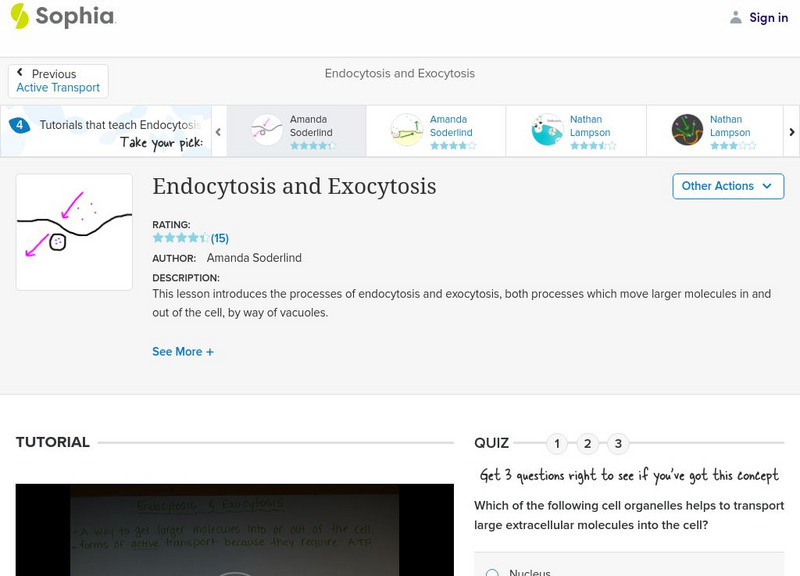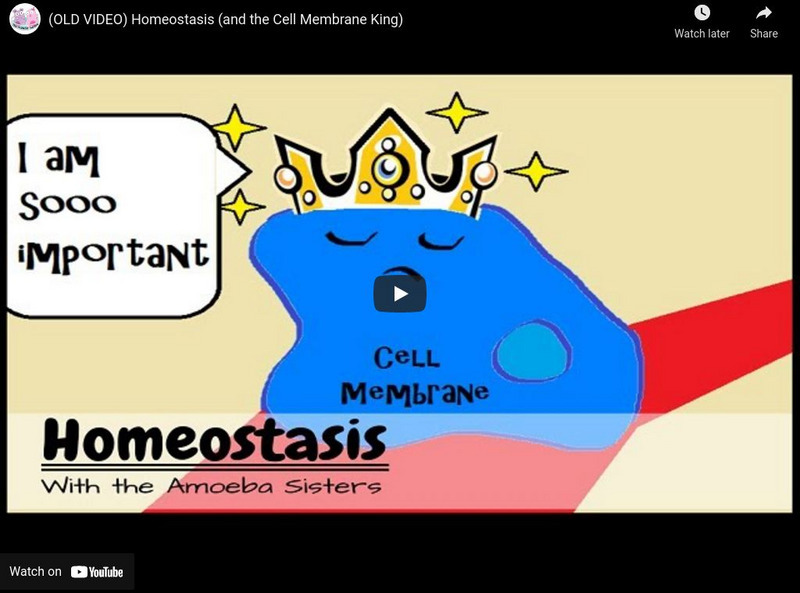Hi, what do you want to do?
Khan Academy
Khan Academy: How Do Things Move Across a Cell Membrane?
Learn how different compounds are able to move across the cell membrane to get where they need to go. [11:50]
Museum of Science
Ei E: Designing a Model Membrane (1)
Students focus on the bioengineering problem of meeting the basic needs of an organism as they imagine, plan, create, test, and improve their own model membrane.
Museum of Science
Ei E: Just Passing Through: Designing Model Membranes Lesson 3 Part 2
Students explore properties of natural membranes and test the performance of several model membrane materials. [19:02]
Museum of Science
Ei E: Just Passing Through: Designing Model Membranes, Lesson 3 Part 1
Students explore properties of natural membranes and test the performance of several model membrane materials. [19:18]
Museum of Science
Ei E: Just Passing Through: Designing Model Membranes Lesson 1
A storybook introduces the engineering challenge and context. In this story, Juan Daniel, a boy from El Salvador, learns about bioengineering as he designs his own model membrane. [14:31]
Museum of Science
Ei E: Just Passing Through: Designing Model Membranes Lesson 3 Part 2
Students explore properties of natural membranes and test the performance of several model membrane materials. [19:33]
Museum of Science
Ei E: Just Passing Through: Designing Model Membranes Lesson 3 Part 1
Students explore properties of natural membranes and test the performance of several model membrane materials. [18:52]
Museum of Science
Ei E: Just Passing Through: Designing Model Membranes Lesson 1
A storybook introduces the engineering challenge and context. In this story, Juan Daniel, a boy from El Salvador, learns about bioengineering as he designs his own model membrane. [18:27]
Sophia Learning
Sophia: Endocytosis and Exocytosis: Lesson 2
This lesson introduces the processes of endocytosis and exocytosis, both processes which move larger molecules in and out of the cell, by way of vacuoles. It is 2 of 4 in the series titled "Endocytosis and Exocytosis."
Amoeba Sisters
Amoeba Sisters: Homeostasis
A video explaining why homeostasis is necessary and how the cell membrane controls the cell's homeostasis. Teachers can visit Amoeba Sisters' website for a handout that goes along with video. [4:12]
Crash Course
Crash Course Biology #5: In Da Club Membranes and Transport
Hank describes how cells regulate their contents and communicate with one another via mechanisms within the cell membrane. [11:44]
Khan Academy
Khan Academy: New Topic: Membrane Potentials Part 2
Find out how a cell that is permeable to one ion can become charged (either positive or negative) if there is permeability and a concentration gradient in this video lecture. Also discussed is an equation to calculate the membrane...
Sophia Learning
Sophia: Cell Membranes
Discover in detail, the structure and function of the cellular membrane. [5:56]
Sophia Learning
Sophia: Plasma Membrane
This lesson will describe the structure and function of the plasma membrane of a cell.
Khan Academy
Khan Academy: Energy and Transport: Sodium Potassium Pump
Learn how the sodium-potassium (Na+/K+) pump works, and its role in establishing resting membrane potentials. [7:17]
Khan Academy
Khan Academy: Cells: Fluid Mosaic Model of Cell Membranes
The fluid mosaic model describes the cell membrane as a tapestry of several types of molecules that are constantly moving. This movement helps the cell membrane maintain its role as a barrier between the inside and outside of the cell...
Khan Academy
Khan Academy: Cell Membrane Overview and Fluid Mosaic Model
Learn about the major components that make up our cell membrane in this video. Also, explore how the fluid mosaic model describes how the cell membrane functions. [8:52]
Khan Academy
Khan Academy: Cell Membrane Introduction
A video explaining how the cell membrane is formed by a phospholipid bilayer. Learn how this membrane allows some molecules to passively move through while others cannot pass the membrane. [8:51]
Khan Academy
Khan Academy: Cell Membrane Proteins
A video reviewing over the membrane proteins, how they function, and how they help makeup the cell membrane's structure. [8:11]
Khan Academy
Khan Academy: Sodium Potassium Pump
This video explains how a sodium-potassium pump can maintain a voltage gradient across a cell or neuron's membrane. The sodium-potassium pump goes through cycles of shape changes to help maintain a negative membrane potential. [13:52]
Khan Academy
Khan Academy: Cell Membrane Fluidity
The resource from Khan Academy and the Association of American Medical Colleges provides study content for the MCAT. This resource discusses how the phospholipids in the cell membrane maintain membrane fluidity. By William Tsai.
Khan Academy
Khan Academy: Uniporters, Symporters and Antiporters
Uniporters, symporters, and antiporters are proteins that are used in the transport of substances across a cell membrane. This video describes how each of these works in the transport process. [7:13]
Next Vista for Learning
Next Vista for Learning: Animal Cells
A video explaining the structure and function of the basis organelles found in an animal cell. [1:23]
Bozeman Science
Bozeman Science: Cell Membranes
Paul Andersen explains how cells are selectively permeable with the help of their cell membrane. The main constituents of the cell membrane, including cholesterol, glycolipids, glycoproteins, phospholipids, and proteins are included. The...























